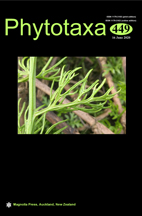Abstract
During a survey of saprobic microfungi in Thailand, a dothideomycetous fungus was found on a dead twig of Delonix regia, on the Chiang Mai University campus. This fungus is characterized by fully immersed ascomata under a small blackened pseudoclypeus, pseudoparenchymatous peridium, cellular pseudoparaphyses, cylindrical-clavate asci with a distinct pedicel, overlapping 3–4-seriate, pale to dark brown, broadly fusoid, 7–9-transversally septate ascospores with a vertical septum in nearly all median cells. Multigene phylogenetic analyses, using partial sequences from the 28S nrRNA gene (LSU), 18S nrRNA gene (SSU), internal transcribed spacer regions and intervening 5.8S nrRNA gene (ITS) of the nrDNA operon and the translation elongation factor 1-alpha region (TEF) demonstrated a monophyletic affiliation of the new strain, accommodating the species of Phaeoseptum in the family Phaeoseptaceae. With further morphological and phylogenetic investigations, we justify the new fungus as a novel species, Phaeoseptum hydei in Phaeoseptaceae. Detailed descriptions and illustrations are provided for Phaeoseptum hydei and this novel species compared with the remaining species found in the genus. An updated checklist of microfungi recorded on Delonix regia from around the world is also provided.

